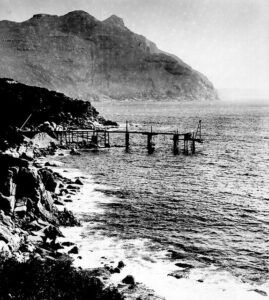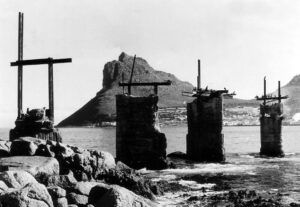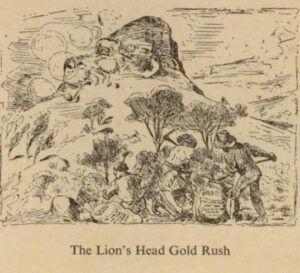The Hout Bay Manganese Mine
There are a couple of deposits of manganese on the Cape Peninsula. They are not large and the phosphorous content is high. Deposits were worked in the Constantiaberg in 1880. There were also deposits found on the slopes above where Chapman’s Peak is today. Hout Bay Manganese Ltd was formed in 1909 by A J Parker. There were no tarred roads and the ore was transported by sea. A 750-metre chute was constructed at 45 degrees from corrugated iron to move the ore from where it was mined onto the boats. Ore tumbled down the chute. A crane hoisted the ore into cocopans, which were railed along a specially built jetty and then onto a barge. The ore was sent to Britain and Belgium. Unfortunately, while the idea of the chute was good, the ore overheard as it tumbled downwards and the ore often got stuck. Clearing it involved taking the chute apart and the ore loosened with dynamite blasting.


Jetty at the base of the chute used to move the ore
The mining methods however were slow and inefficient. In 1910 some 5000 tons of ore were produced, but in 1911 just 130 tons. The mine closed down and all that can be seen today are the concrete pillars of the jetty jutting out into Chapman’s Bay. The old adits form an interesting for mountain climbers to see. Hout Bay Museum.
The Zilvermyn on the Steenberg (Silvermine)
The Dutch looking for deposits of silver mistook other minerals for it. Before more sophisticated ways to identify the metal identification relied on the unaided eye, and the only known microscope and “burning glass” belonged to Governor Simon van der Stel. The best known of the “silver mines” is the Zilvermyn in the Steenberg district, THis is one of three mines, the others were on either side of the Silvermine River in the valley below.
An entry in “The Company’s Diary dates 15 November 1687 Simon Van Der Stel, on his way to the bay that was later named Simons town after him, found three company employees who were stationed at the mine, walking on the beach in possession of two muskets. They claimed to be searching for runaway slaves. It is more likely they were enjoying a hunting trip. Some months later an inspection of the mines found them ruined. A large quantity of ore was found. It was thought to be copper ore but it turned out to be coarse hematite mixed with copper dust. The shaft had collapsed. In 1686 the company’s Chief Miner, Frederick von Werlinckhoff, claimed to find silver on Van der Stel’s farm Witteboomen. A sixteen-fathom shaft was dug in what is now Cecelia forest. After a dispute, the miners requested a transfer. A suspicious Van Der Stel asked another Chief Miner, Gabriel Moller, to investigate. The investigation revealed that there was no silver. transfer The mines were never offered up for sale and remained the property of the Dutch East India Company.
Clays, Brickmaking, and Kaolin
Shale clays formed in Malmesbury shales are suitable for brickmaking. Over the years brickfields were established where these deposits were plentiful.
The first was in 1654, next to The Company’s Garden, where a “tile baker” named Wouter Mostert formed bricks for use in the early buildings of the colony. Since then, there have been many deposits found especially in the area around Devil’s Peak, and Signal Hill.
A company called Caporn and Co. was formed in Tamboerskloof in 1898. A patent Bennett and Sayers plant, powered by a Clench engine, and boilers by Arnold of Lancashire could make 20,000 bricks a day. There was a 45-metre-high smokestack. Clay was conveyed by a pulley system.
the 1920s however Tamboerskloof was given over to residential development. Hare’s Lime Kiln and Brickfields began in 1835 in Mowbray. When these brickworks were demolished a magnificent, old Dutch kiln was destroyed. to make way for the Forest Hill apartments on the Main Road. There is a brickwork mural of the old kiln on the Main Road façade of the building.
Another type of clay is kaolin, or china clay, which is used for the making of ceramics. It is formed by the alteration of feldspars in granite. It has been actively mined in the Fish Hoek Valley since 1953. The main client is Continental China.
Mining was done by by Serina Kaolin (Pty) Ltd, at Brakkloof. Quartz, mica, and other unwanted minerals were removed from the clay. This was filtered, purified, and then compressed into cakes for easy handling. A new mine was later opened on the northern side of the Noordhoek valley, on the slopes of Chapman’s Peak.
Salt
Before fridges were common kitchen appliances much food was preserved using salt. Salt was a valuable commodity and The Roman soldiers were given a salt ration with their pay called a “salarium”, and our modern word “salary” comes from this.
The Dutch settlers first mined salt at Rietvlei and Paarden Eiland however a better quality of salt was found at Noordhoek Salt Pan, which was first worked in about 1817. Today the salt pan is overgrown with vegetation but it can still be seen.. It was regularly replenished with fresh brine during winter high tides. The pan proved to be uneconomical when salt from other places was much cheaper and more plentiful.
The pan was used for anything in the early 1930s and it was not for collecting salt! The vegetation was cleared and was converted the saltpan into Cape Town’s very first motor racing circuit. Until 1935 when the sport moved to Pollsmoor.
Limestone (Calcrete)
The first lime for cement making was manufactured in Kalk Bay. (Lime Bay) It was obtained by burning sea shells. There were big deposits of calcrete on the False Bay coast, which is a low-grade limestone mixed with sand. cliffs at Swartklip and Booi se Skerm, where there are also shallow caves are composed of this. These cliffs are in the Cape of Good Hope Nature Reserve. In 1890 John McKellar built a lime kiln here, where he burnt calcrete. The kiln was designed so that wagons could drive up and have the product tipped into them.
The company was called the Cape Point Lime and Cement Works. The kiln was restored in 1990 and can be seen in the Reserve. The National Portland Cement Company used calcrete taken from the Cape Flats between 1939 and 1980 on a much larger scale. There is also a limestone quarry on Robben Island. It was formerly worked by prisoners on the island.
Glass Making Sand
There are several deposits of high silica-content glass-making sand on the Peninsula. The first place where glass was made was at Papendorp (Woodstock) The South African glass Company started making glass in 1879. The factory was next to the railway line in Observatory. There was a show room on the corner Burg and Shortmarket Streets on Greenmarket Square. Skilled staff for the factory were brought from England. 500 shares at £10 each were sold. The factory was beset with problems and it was closed in1882.
The next attempt took place in Glencairn in 1902 by the Cape Galss Company They claimed they were able to produce 8 ½ million bottles a year in either dark green or clear aqua-coloured glass,
Glencairn at the time was remote and windswept. The workers were not happy and many returned to Britain and the factory was closed in 1905.
The third attempt happened in Phillipi in 1925 by Consolidated Glass Works Ltd, 2 million tons of sand have been extracted over the years. Consol”s factory at Bellville dates from 1956.

Gold Rush
For a long time, people believed that there were gold deposits at the Cape. Some very small deposits were found, however they were not economical to exploit. A small bit of gold was found on Lion’s head. In 1887 the Cape Argus of 23rd November printed a Supplement about the mine and a mini gold rush began. The Lion’s Head Gold Mining Company was launched and shares were offered. A 45m shaft45 m was sunk and from a ton of quartz containing pyrite, only two ounces of gold was extracted. A further survey concluded that there was a good chance of finding more. , 7 ½ tons of ore was despatched overseas. However, only about 4 kilos were tested and also not by the required methods and no gold was found in the ore. The project was disbanded and the city bought the property. The shaft however remained open until in 1954 a firefighter almost fell into it while battling a mountain fire.
